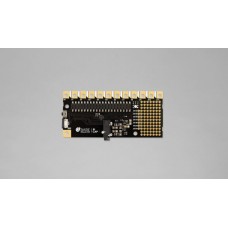Bare Conductive Pi Cap
The Pi Cap adds precise capacitive touch, proximity sensing and high quality audio to your Raspberry Pi.
Connect your Pi project to the physical world. Create sensors by connecting Electric Paint or anything conductive to one of the Pi Cap’s 12 electrodes to control audio, video or connect to the internet. Make a MIDI piano, an interactive wall, a proximity sensor — you decide. Our Raspbian package contains code examples for C++, Python and Node.js.
• Capacitive touch and distance sensing
• High quality audio output
• Tutorials to help you get started
• User-‐programmable RGB LED
• Multi function button
• Prototyping area with GPIO breakout
• Compatible with Raspberry Pi A+, B+, Zero (or any Pi with 40 pin GPIO connector)
• Powerful C++, Python and Node.js libraries and examples
Works with:
Crocodile clips, copper tape, solder and e‐textiles. Use with Electric Paint to design your own sensors
LEVEL: Beginner to Expert Engineer
Getting started with the Pi Cap
We have worked hard to make setting up your Pi Cap as straightforward as possible, whether you’re using a Pi Zero, Raspberry Pi 1 A+/B+, Raspberry Pi 2 or Raspberry Pi 3 our easy-to-follow instructions should help you get started.
Setting up with Raspberry Pi, A+/B+, 2 and 3
Setting up with Pi Zero

Resources
In you’re wondering what the Pi Cap can do or what model Raspberry Pi you should use, we’ve created a series of resources which should answer your questions. If you want to know what the pins on the PCB are for, or whether you should use a Touch Board or Pi Cap in your project. Make sure to check out our Pi Cap guides.
Pi Cap Technical Data Sheet
Pi Cap pin map
Pi Cap Raspberry Pi Guide

Pi Cap Projects
The Pi Cap can be used for capacitive touch or distance sensing. Whether you want to keep it plugged in to a screen or make it a self-standing wearable, there’s loads of opportunities with this tiny and powerful add-on.
Pi Cap Capong Project Tutorial
Unleashing #PugProse with the Pi Cap

Data Sheets:
Pi Cap Technical Data Sheet
Pi Cap Pin Map
Pi Cap Raspberry Pi Guide
TECHNICAL DETAILS
• High quality audio output
• Extensive tutorials and easy startup experience
• Powerful Python and C++ libraries so that you can include sensors in your project
• User-programmable RGB LED and multi function button
• Prototyping area with GPIO breakout to add additional sensors or buttons
• Works with Raspberry Pi A+, B+, Zero and later (Any Raspberry Pi with a 40 pin GPIO connector)
Pi Cap Intro
The Pi Cap features tour walks you through the code examples that are supported by the Pi Cap library to give you an easy start to your project. Featured code examples include:
• Simple Touch – Get data from the Pi Cap showing which electrode has been touched or released
• Datastream-tty – Similar to simple-touch, datastream-tty continuously streams the electrode data
• Datastream-osc – Similar to datastream-tty, but streams OSC packets to a specified host over a network
• Polyphonic Touch MP3 – This example plays mp3 tracks in the tracks folder when electrodes are touched
• Text to Speech – Text files are synthesised (read out) by a computerised voice when you touch electrodes
• Button Utility – A single button press to prints Hello World! to the console, a double press reboots and a long press does a proper shutdown (avoiding corrupting your microSD card)
• LED colour spinner -Display code status, debug or start a tiny rave. Example code loops through a variety of colours – the source code shows you how to manipulate the LED colour.
Precautions of use:
Precautions of use: Children under 14 years of age must be supervised by an adult whilst using this product. This product is intended for use in conjunction with a Raspberry Pi only. Do not use on conductive/metal surfaces as this may short circuit the board and damage it. Bare Conductive takes no responsibility for external circuitry connected to this board.
Enter the code in the box below:











-80x80.jpg)
